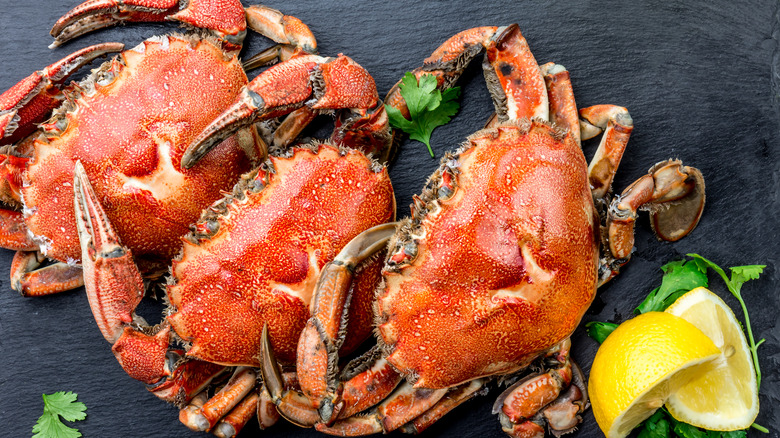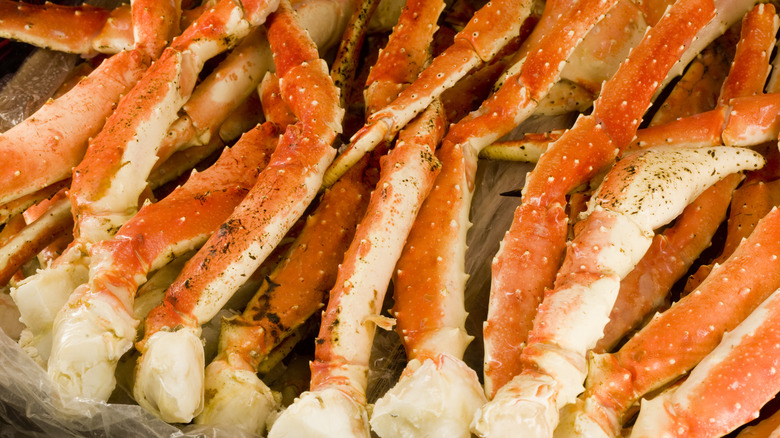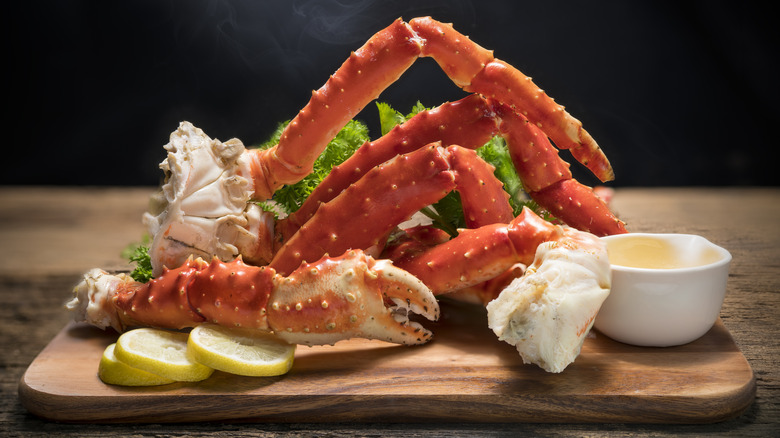Snow Crab Vs. King Crab: The Flavor Difference And How To Eat Them
The difference between king crab and snow crab may be almost indiscernible once the meat is cooked, pulled, and grafted into crab-centric recipes. From crab cakes to gumbos, creamy pastas, she-crab soup, spicy crab bisque, and crab empanadas, that salty-sweet flavor of the sea is unmistakable. However, each crab species has its own aquatic rhythm, differing by body types, habitats, and taste, even if the variations are subtle.
Flavor and texture reign supreme when choosing between a snow crab and king crab, with true crustacean aficionados pointing out even slightly distinguishing features. King crab sets a high standard and, accordingly, carries a higher price. But the splurge is worthy, with thick, firm, meaty crab legs; a rich, sweet taste; and a delicate, creamy texture similar to lobster. Fresh king crabs will leave you craving that flavor for about eight months of the year, since the Alaskan harvest season generally runs only through the months of October to January.
Snow crab harvests come from both the North Pacific and North Atlantic oceans and tend to be more plentiful, with longer seasons generally ranging from October through April. The taste is similar to king crabs — they have an overall delicate sweetness, but balanced by gentle briny inflections and intricate flavor notes. The texture of snow crab is more fibrous and chewy, making it a nice addition to salads and pasta dishes.
The two crabby cousins vary significantly in size, but that only slightly affects how you cook and eat them.
Preparing king and snow crab for eating
Size usually matters when cooking seafood, but not so much with crab legs. That's because almost all crab available in the marketplace is pre-cooked onboard the crabbing vessel and flash-frozen to preserve freshness as it travels from boat to market to table. So, "cooking" whole crabs, crab legs, or crab claws is basically just warming them up.
Though kings average 6 pounds and sometimes up to 20 pounds, and snows weigh in at 2 to 4 pounds, the heating time is pretty much the same using most methods. Take your pick — crab handles heat from boiling, baking, steaming, grilling, and even instant pot preparation.
Steaming or boiling snow or king crabs takes about 5 to 8 minutes using 2 cups of water, 1 tablespoon of salt, and any preferred seasonings. You can bake them in a 350-degree Fahrenheit oven for 8 to 10 minutes, using about ¼-inch water in the bottom of the pan if you'd like them extra steamy.
The exception is when cooking fresh crab caught locally. Since they're not pre-cooked, the size difference between kings and snows comes into play. The thinner snow crab legs will take longer to cook than the extra-thick kings, especially when baking. Fresh snow crab legs can require up to 25 minutes in the oven, while kings may need as many as 35.
You'll know crabs are cooked when the exterior shells turn bright red or orange, and the interior meat is white and flaky.
Time to eat those tasty cooked king and snow crabs
Eating snow and king crabs is similar, though kings typically require a metal cracking device because of their much thicker legs and tough shells. Absent a dedicated crab cracker, you can improvise with a sanitized pair of pliers, a nutcracker, or even a simple hammer. Smash them gently to avoid shattered pieces, but hard enough to make a crack in each leg. From there, it's usually possible to finish the break with your hands — just be aware of the spiky protrusions on king crab legs.
Snow crab legs generally don't require an external implement — just snap the long, thin legs with your fingers, and pull out the delicate, juicy, sweet meat. It's also possible to eat meat from the crab claws in either species, though the meat isn't as plentiful in snow crabs and can be harder to reach. Some people venture into the crab's body, but you might have to wade through a lot of organs, cartilage, and other unappealing bits to find edible portions.
Both kings and snows are super tasty dipped in clarified butter or ghee, cocktail sauce, aioli, sriracha, tartar sauce, garlic-infused olive oil, and any flavorful sauce you dream up.



